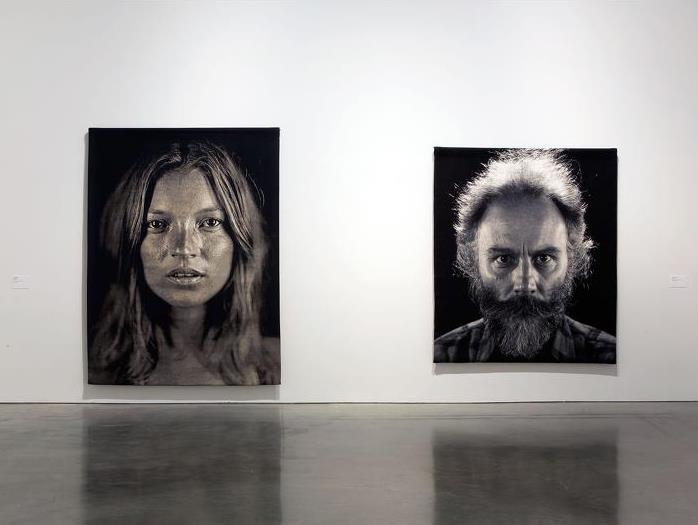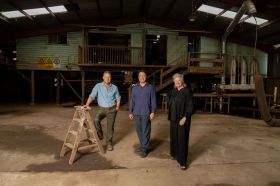Chuck Close: Prints, Process and Collaboration, installation view, Museum of Contemporary Art, Sydney, 2014, courtesy the artist and Pace Gallery, New York © Museum of Contemporary Art photograph: Jess Maurer
Bob may not be your uncle, but he is a familiar face to many of us. American artist Chuck Close’s large, airbrushed painting of his friend Robert Israel, made in 1969-70, has had pride of place at the National Gallery of Australia for nearly four decades. Now, Bob has left the walls of our national institution for the first time in 15 years to take up temporary residence at the Museum of Contemporary Art Australia in Sydney amongst the artist’s extraordinary prints and multiples.
Chuck Close: Prints, Process and Collaboration is an impressive and intriguing survey. Although audiences are familiar with Close’s supersized portrait paintings such as Bob, they may not be familiar with his prints. This exhibition highlights the importance of printmaking to the artist’s practice, exhibiting state proofs, plates and other process material along with the finished work. This allows the viewer to gain a fuller understanding of the different types of printmaking, as well as an insight into Close’s personality and how that manifests in his art practice. As Exhibition Curator Terrie Sultan, who has worked with Close on the exhibition for many years, explained:
‘Printmaking is very key to Chuck. It is a place for him to really experiment, and he has said many times that almost every innovation that he has experienced in a painting has come about as a direct result of something he learned from making a print. And the place where that is the most obvious is the first print that he ever made, which is the focus of one entire room in this exhibition, Keith/Mezzotint.’
Aside from Bob, Keith/Mezzotint is another of Australia’s significant contributions to the exhibition, also drawn from the collection of the NGA. Sultan enthused, ‘It just shows you how incredibly forward looking the directors and the curators here in Australia were in the 1970s, when people in America were not collecting Chuck’s works.’
Made in 1972, it represents the first time the artist tackled this particularly labour-intensive medium, as well as the first time Close ‘showed his hand’ in revealing the underlying grid structure that is now synonymous with his images. Like many of the developments in the artist’s practice, this revelation was an accident embraced by Close. As Sultan revealed:
‘In the process of making that print, the grid line that [Close] had always used in order to organise the composition [and] transfer information from the photograph to the painting, wore down from the plate because of the way a mezzotint is made. [So] when they started taking the proofs you could see the grid.
‘That was a huge revelation to him, [and] he said to himself, ‘henceforth, I’m going to show everybody why that grid is so important to me.’ So it was transformational to him in terms of how he went forward with his paintings after making that print. And it’s been true in almost every instance he has experimented with a print, that he has been able to take something that he has learned and used it in a painting.’
The exhibition allows the audience to follow the threads of these developments, with the familiar faces of Close’s subjects as guides. Composer Philip Glass is the eponymous Phil we see in many of these images. The original photograph, taken by Close nearly four decades ago, has served as the basis for several prints in the exhibition.
Glass is also the subject of Phil/Tapestry (1991), a small piece manufactured in silk on a Chinese loom to instructions provided by the artist. Years later, with the encouragement of Donald Farnsworth (one of his many collaborators in the world of multiples), Close returned to the medium, creating large-scale jacquard tapestries based on photographs of his friends. Several of these, including Roy Lichtenstein, Lou Reed and Kate Moss feature in the exhibition.
Like all Close’s images, these apparently monochrome tapestries defy belief when viewed in the flesh. ‘They are absolutely full of colour,’ said Sultan. ‘You think you’re looking at black and white, and you get close to them and see how many colours there are, and you understand how colour theory works. There is no such thing as black, black is just the aggregate of every other colour in saturation.’
This layering is vital to the way Close approaches all materials. Whether peering in at the myriad of tiny abstract paintings that constitute the painting of his niece Emma, or examining a selection of the intricate woodblocks that led to the complex and beautiful print of the same subject, Close appears to see detail beyond the wildest imagination of most.
Indeed, he is known amongst his master printmaker collaborators for pushing the limits of possibilities, taking those around him on what Sultan terms a ‘voyage of discovery’ where clearly the process is as important as the final outcome. And in Chuck Close: Prints, Process and Collaboration, the audience is invited along on this voyage of discovery too. From felt hand stamps to paper pulp works, the ambition, skill and technique that has gone into producing these works is a wonder to behold.
Consulting Curator Glenn Barkley said that ‘Chuck was a magician when he was a kid. The golden rule of being a magician is that you never reveal how the trick is made, whereas Chuck wanted to reveal the trick. He also does that with the prints. He shows you how they’re made, but it actually makes them more magical when you realise all the work that’s gone into them.’
Head over to the MCA this summer and prepare to be amazed.





